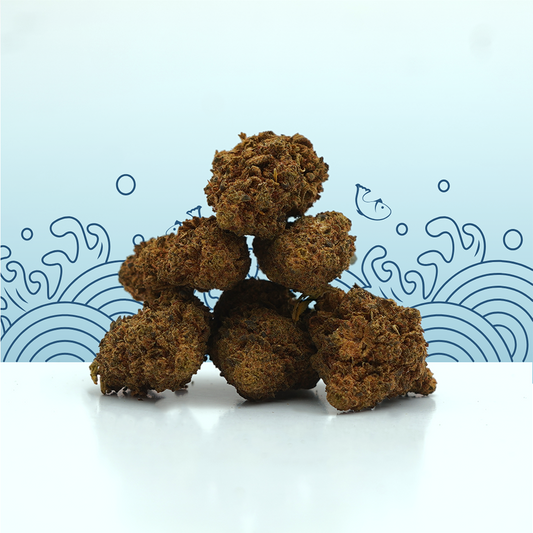Here's a detailed list of the main natural cannabinoids present in cannabis. The aim is to better understand their roles, effects and importance in your experience of well-being and relaxation.
To remember
- Cannabinoids interact naturally with the body to restore balance.
- Each cannabinoid has its own benefits for the body.
- Cannabinoids and terpenes create a more complete synergy to amplify the benefits, known as the entourage effect.
The role of cannabinoids: how do they work?
Hemp is a complex plant containing numerous active compounds, such as cannabinoids. These molecules interact with the endocannabinoid system, a network of receptors present in the human body. These receptors play an essential role in regulating biological functions such as pain, mood, sleep and appetite.
Cannabinoids work by binding to CB1 and CB2 receptors in the nervous and immune systems. This interaction helps restore internal equilibrium, a natural process also known as homeostasis.
Unlike artificial substances that abruptly alter brain chemistry, cannabinoids stimulate the body's natural self-regulation mechanisms. Their gentle, natural action makes them a popular alternative for soothing and relaxing you.
List of the main cannabinoids in cannabis
THC (tetrahydrocannabinol)
The THC is the best-known cannabinoid in cannabis, mainly responsible for the so-called "high" or euphoric effects. It acts on the brain by altering perception, concentration, mood and sometimes even bodily sensations.
It is mainly found in so-called recreational varieties of cannabis. It is the subject of much research to better understand its impact on the body and mind. In the future, it could well be integrated into treatment approaches for specific illnesses.
It comes in different forms, such as Delta-9, the most common, or Delta-8, a milder version. THC remains highly regulated, and its legality varies from country to country.
However, for an effective entourage effect, CBD products on the market retain a minute level of THC.
CBD (cannabidiol)
The CBD has no psychotropic effects. It is appreciated for its soothing action, which helps you relax, sleep better or regain a certain balance in your daily life.
Unlike THC, it is authorized for sale, even in countries where cannabis is banned. Today, it can be found in several forms: oils, infusions, creams or e-liquids, and its use is becoming increasingly common.
CBG (cannabigerol)
Visit CBG is a cannabinoid present in small but very important quantities. It is the "mother molecule" from which other cannabinoids, such as THC and CBD, are derived.
There is growing interest in its potential effects on mood, energy and mental clarity. Some varieties of hemp are now being specially bred to contain more CBG. Because its effects may be suitable for some consumers.
CBN (cannabinol)
The CBN is formed naturally when THC oxidizes over time. It is therefore more present in aged or poorly preserved cannabis. It does not produce a euphoric effect, but is often associated with a feeling of deep calm.
Some people seek out CBN-enriched products to relax or promote more peaceful sleep. Less well-known than CBD or THC, it is gradually gaining popularity in hemp-based products.
Minor cannabinoids: secondary but important players
In addition to major cannabinoids such as THC or CBD, cannabis contains numerous minor cannabinoids, present in smaller quantities, which greatly influence the action of cannabis.
CBC (cannabichromene) interacts with other cannabinoids and may enhance the entourage effect. It is often associated with a feeling of well-being and may play a role in mood balance.
THCV (tetrahydrocannabivarin) is often compared to THC, but is distinguished by its much milder and sometimes even opposite effects. In particular, it has been studied for its ability to regulate appetite and boost energy, with effects that are more stimulating than relaxing.
Finally, CBDV (cannabidivarin) is closely related to CBD. It is attracting attention for its effects on the nervous system, notably in some research into neurological disorders.
The entourage effect or cannabinoid synergy
The entourage effect describes how the cannabinoids and terpenes in cannabis interact to amplify or balance their effects. Rather than acting alone, these compounds create a natural synergy that makes the experience more complete. For example, CBD can mitigate some of THC's effects, such as anxiety, while enhancing its benefits.
Terpenes, which are responsible for aromas, also influence the action of cannabinoids in the body. Choosing a full spectrum product preserves all the plant's cannabinoids and delivers stronger effects.
Depending on their cannabinoid composition, some products may promote relaxation, others concentration or energy. Mama kana offers you CBD oils oils, enriched with CBN and CBG, to find more personalized products to suit your personal needs.




![Banana Cream CBG 🍌 [Greenhouse]](http://mamakana.com/cdn/shop/files/banana.jpg?v=1683038126&width=533)
![Bubba Kush CBD 🫧 [Greenhouse]](http://mamakana.com/cdn/shop/files/Bubba_fond_4b55b9bd-2083-406f-8843-1229994bb3ec.png?v=1738679473&width=533)




